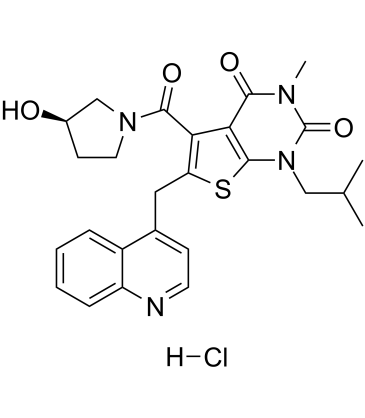AR-C141990 hydrochloride
Modify Date: 2025-08-27 11:45:43

AR-C141990 hydrochloride structure
|
Common Name | AR-C141990 hydrochloride | ||
|---|---|---|---|---|
| CAS Number | 2250019-94-2 | Molecular Weight | 529.05 | |
| Density | N/A | Boiling Point | N/A | |
| Molecular Formula | C26H29ClN4O4S | Melting Point | N/A | |
| MSDS | N/A | Flash Point | N/A | |
Use of AR-C141990 hydrochlorideAR-C141990 hydrochloride is a potent lactate transporters (monocarboxylate transporters; MCTs) inhibitor with pKi values of 7.6, 6.6 for MCT-1 and MCT-2, respectively[1]. AR-C141990 hydrochloride has immunosuppressive properties and inhibits graft versus host response[2]. |
| Name | AR-C141990 hydrochloride |
|---|
| Description | AR-C141990 hydrochloride is a potent lactate transporters (monocarboxylate transporters; MCTs) inhibitor with pKi values of 7.6, 6.6 for MCT-1 and MCT-2, respectively[1]. AR-C141990 hydrochloride has immunosuppressive properties and inhibits graft versus host response[2]. |
|---|---|
| Related Catalog | |
| Target |
pKi: 7.6 (MCT-1) and 6.6 (MCT-2)[1] |
| In Vitro | AR-C141990 hydrochloride has no significant activity against MCT-3 (pIC50<5) or MCT-4 (pIC50<5)[1]. AR-C141990 hydrochloride inhibits the uptake of [3H]HOCPCA in oocytes expressing MCT1 or 2 in a concentration-dependent manner with IC50s of 0.21 µM and 2.32 µM, respectively[2]. |
| In Vivo | AR-C141990 hydrochloride (10 mg/kg; SC) with a parallel decline in plasma concentrations with a half-life around 20 minutes in male NMRI mice (18-22 g) [2]. Application of the corresponding plasma concentrations of AR-C141990 hydrochloride (0.3-90 mg/kg) results in a concentration-dependent decrease in the B/P of HOCPCA with an EC50 of 860 ng/ml[2]. AR-C141990 (100 mg/kg; s.c.) has a moderate prolongation of graft survival for 40 days in PVG rats that received DA cardiac transplants[1]. |
| References |
| Molecular Formula | C26H29ClN4O4S |
|---|---|
| Molecular Weight | 529.05 |
| Hazard Codes | Xi |
|---|